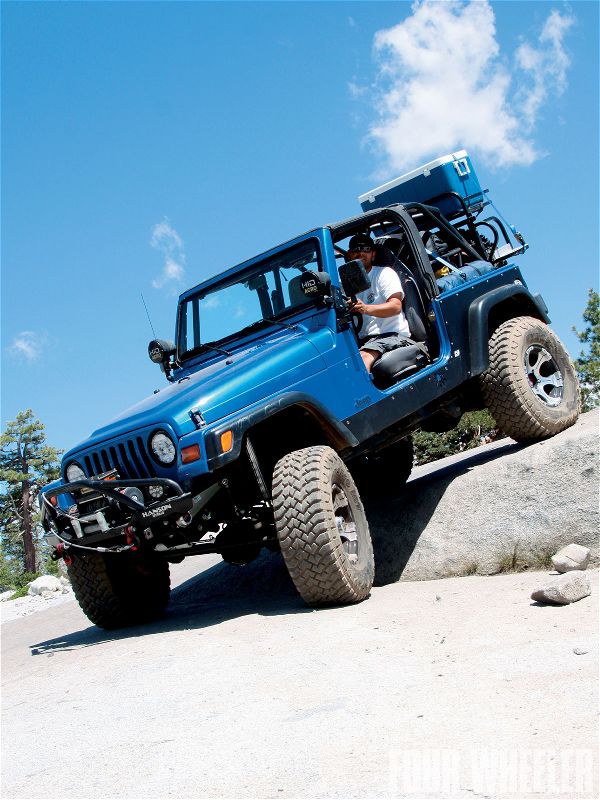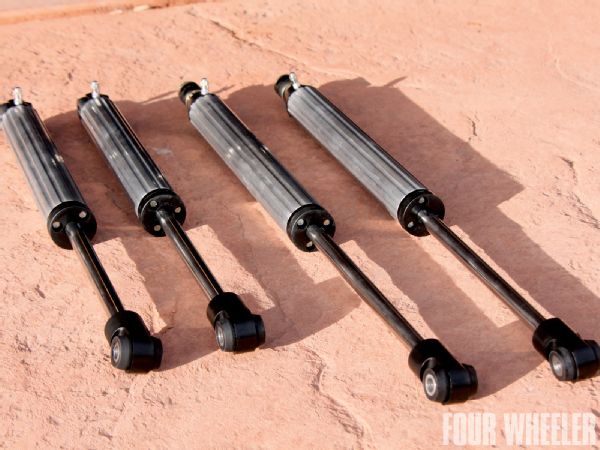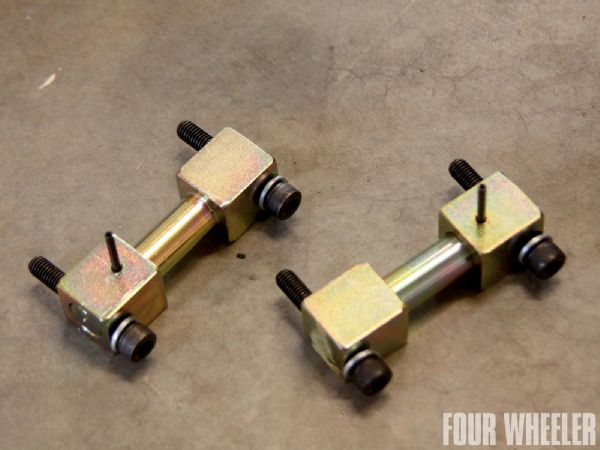
Every so often, something new and innovative passes over our desks. When it happens, we jump at the opportunity to secure an exclusive first-hand evaluation. This was the case when our friends at Rock Krawler Suspension announced a new line of 2.0 emulsion shocks that are configurable with remote reservoirs or as coilovers. These new shocks feature some of the latest advancements in shock theory and design, yet are going to be priced well within reach of the average consumer. After spending more than two years in the research and development phase, Rock Krawler's engineers claim to have found the best combination of materials to allow the new design to excel in virtually all disciplines of four wheeling. In addition, extensive winter testing on salt- and sand-covered roads has ensured that harsh environmental conditions will not affect the exterior finish or the sealing integrity of these units.
 We tested the new RRD 2.0 Emulsion shocks on a '97 Jeep Wrangler TJ sporting a 4-inch JKS J-Spec short suspension system along with a Full Traction 5-inch Stealth Stretch conversion. Our testing included lots of pavement driving, a trip over the Rubicon Trail, mud bogging at Hollister Hills, and some high-speed desert driving near Palm Springs, California.
We tested the new RRD 2.0 Emulsion shocks on a '97 Jeep Wrangler TJ sporting a 4-inch JKS J-Spec short suspension system along with a Full Traction 5-inch Stealth Stretch conversion. Our testing included lots of pavement driving, a trip over the Rubicon Trail, mud bogging at Hollister Hills, and some high-speed desert driving near Palm Springs, California.
The intriguing part about this new design is the unique process by which the shock bodies are made. Instead of using the traditional steel tube body format like most shock manufacturers, RRD Racing shocks have 6063 aluminum bodies that start out as an extrusion. An aluminum extrusion is formed by pressing molten aluminum material through a specifically shaped die, similar to the way dough is transformed into a churro. The exterior surface of the shock-body extrusions feature fluting, or fins, designed to improve thermal efficiency. These fins create additional exterior surface area for air to pass over. Moreover, because aluminum dissipates heat at a higher rate than steel, the cooling effect is compounded even further. Aluminum does not rust like standard steel-bodied shocks with cadmium plating, nor will it chip like a clearcoat finish, so these shocks should remain shiny for many years to come.
Also, the shock's inner bore features a micropolished surface to further reduce friction between the piston seal and the inner diameter of the body. The result is a much lighter-weight shock that provides vastly improved cooling characteristics over traditional steel-bodied shocks. Currently, the only other racing shock that uses an extruded body is the ultra-high-end Bilstein Blackhawk.
Extrusions are an excellent choice for manufacturing a shock body because of numerous features and benefits. For example, extrusions offer time- and cost-efficiencies while satisfying a range of performance criteria that is virtually unmatched by other materials and processes. The extrusion process enables a high level of repeatability, offering less variation in tolerances-an important consideration for any shock manufacturer. Follow along as we dissect the innovative attributes of the new RRD 2.0-inch emulsion shocks.
How Did They Work?
In a word, awesome. We ordered our shocks with slightly stiffer valving than stock because our test rig had lots of heavy steel aftermarket accessories installed on it. We figured that the stiffer valving would help eliminate body roll and increase high-speed stability. We evaluated our new RRD shocks in virtually every environment imaginable. In slow rockcrawling scenarios the shocks performed flawlessly, returning smooth damping on the compression side. While our donor Jeep was no Trophy Truck, we did manage to traverse some high-speed whoops sections during our desert testing. We found compression to be predictable and acceptable during high-velocity impacts, but we found that rebound needed a slightly lighter valve setting to increase downstroke velocity or droop-out speed. The cool thing about these shocks is the fact that the end user can actually take them apart using standard hand tools. This allows the customer the ability to fine-tune each valve profile to his or her liking.

During our testing, we racked up nearly 2,800 miles, combining a good mix of on- and off-pavement excursions. On the road, we noticed a lot less body roll as the vehicle entered into a corner at speed. We took our evaluation units off and returned them to Rock Krawler for a slight change in length to accommodate another inch of uptravel. The guys at Rock Krawler took each unit apart and inspected all of the sealing surfaces for wear. They didn't find anything unusual about our test units, so they shortened the bodies as we requested, lightened the rebound valving a bit, and reassembled and packaged them for shipping. Within a few weeks, we had the shocks installed on our donor rig in time for the next trail ride.
Ditch the Bar Pins
For this story, we used JKS Bar Pin Eliminators on the rear upper shock mounts to prevent distortion of the shock absorber bushings. These little add-ons make a big difference in terms of bushing longevity-especially where flexible suspensions and added vehicle weight combine to stress bushing materials. In addition, they help the bushings maintain their intended shape when lateral forces try to twist the bushing from the shock eye. They have also been known to prevent annoying noises that sometimes occur with standard OEM bar pins. Bar Pin Eliminators utilize a system of blocks and pins machined from premium-grade, zinc-plated steel. When installed, the blocks actually squeeze the bushing to create the recommended amount of preload specified by bushing manufacturers, thus providing the ideal environment for proper bushing operation. Info: JKS Manufacturing, 308/762-6949, www.jksmfg.com
 PhotosView Slideshow
PhotosView Slideshow








